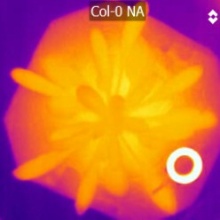Survival of sub-zero temperatures can be achieved by either avoiding or tolerating extracellular ice formation. Conflicting evidence has been presented showing that detached leaves of Arabidopsis thaliana are either freeze avoiding or tolerant. Here, we used three different natural Arabidopsis accessions from different habitats to investigate the frost resistance strategy of whole plants in soil. Plants were cooled to fixed temperatures or just held at their individual ice nucleation temperature for different time intervals. Tissue damage of whole plants was compared to the standard lethal temperature determined for detached leaves with external ice nucleation. While all detached leaves survived freezing when ice nucleation was externally initiated at mild sub-zero temperatures, whole plants of the southern accession behaved as freeze avoiding in the non-acclimated state. The northern accessions and all cold acclimated plants were freezing tolerant, but the duration of the freezing event affected tissue damage. Because this pointed to cell dehydration as mechanism of damage, the proportion of freezable water in leaves and osmolality of cell sap was determined. Indeed, the freezing tolerant accession Rsch had a lower proportion of freezable water and higher cell sap osmolality compared to the sensitive accession C24 in the cold acclimated state.


